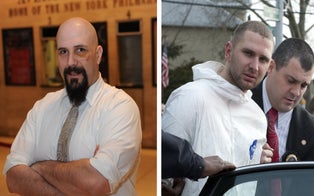In light of Netflix's intriguing documentary, "The Keepers," InsideEdition.com looks back on the case of another nun found brutally murdered.
Warning! Spoilers for Netflix's 'The Keepers' are below.
As Netflix spotlights the mysterious 1970 murder of Sister Cathy Cesnik in The Keepers, the docuseries has fueled fresh interest in the savage killing of another nun a decade later.
There are striking similarities between the murder of Sister Cathy in Baltimore and the 1980 killing of Sister Margaret Ann Pahl in Ohio: Both slain nuns, decades of unanswered questions, allegations of a cover-up by authorities in a staunch Catholic community — and a priest at the center of it all.
Read: O.J. Simpson's Forgotten First Wife: Who is Marguerite Whitley?
The Keepers, which follows citizen sleuths trying to crack the unsolved murder of Sister Cathy, suggests the chaplain of Archbishop Keough High School — Father A. Joseph Maskell — was involved in the murder after at least one student confided to the nun that he was sexually abusing her.
Neither sexual abuse nor murder charges were ever brought against him, leading his former students to speculate whether there had been a cover-up by authorities. A judge refused to re-open the case years later since the statute of limitations had passed and Maskell passed away in 2001.
“We have no evidence or information indicating that there was a cover-up from the Baltimore County Police Department," police spokeswoman Elise Armacost told InsideEdition.com. "No one has ever come to us about any information on any wrongdoing by police."
She added: “We have said repeatedly if anyone has information in connection to this case from 47 years ago to come forward and no one has come forward. We are aware of the vague allegations of wrongdoing and unless someone comes forward with concrete information we have no evidence. If someone has information, we strongly encourage them to come forward before this case gets any older."
But in the case of Sister Pahl, a new generation of detectives managed to pin the murder on a priest, Father Gerald Robinson, bringing some semblance of closure to her family while raising questions of just how far a community will go to protect its clergy.
The Murder of Sister Margaret Ann Pahl
On April 5, 1980, the day before Sister Pahl was to celebrate her 72nd birthday, she was found murdered in the chapel of Toledo Mercy Hospital in Toledo, Ohio.
She had ministered over the sick and terminally ill inside the hospital, and worked as the chapel’s caretaker. On the morning of her death, she was inside the chapel preparing for the following day's Easter services.
She was later found strangled and stabbed more than 30 times, including nine wounds across her chest in the shape of an inverted cross, a satanic symbol. She was partially covered in an altar cloth, which had absorbed much of her blood. Blood was also smeared across her forehead as if her last rights had been administered.
The grisly scene was made to look like a satanic ritual. It also appeared as if she'd been sexually assaulted, although that allegation remains unclear.
Two police officers were inside the hospital settling in for breakfast when a nurse came running to them frantic about the nun’s bloodied body. As the officers raced to the chapel, so did two chaplains at the hospital, Reverend Jerome Swiatecki and Father Gerald Robinson.
The Investigation
As the police kicked off their investigation, they questioned hundreds of hospital staffers, other Sisters of Mercy, the Catholic clerics who worked with her, as well as Father Robinson.
Robinson, who presided over Sister Pahl’s funeral, was questioned by police after they found a letter opener in his desk. At the time, the news of the sword-shaped letter opener, which authorities say fit the size of some of the stab wounds, was never made public.
Cops also reported he'd appeared cold and aloof after seeing the nun's slain body.
The priest, who grew up in Toledo, was viewed as a pillar of the community.
Read: After Man Spits on Sidewalk, DNA Allegedly Links Him to Rape and Murder of 2 Women
“Toledo was a strong Catholic city and area,” author David Yonke, who wrote a book about Sister Pahl's murder entitled Sin, Shame & Secrets, told InsideEdition.com.
“Church leaders were involved in running the town and the Bishop was the most powerful.”
Yonke claimed that “priests could not be arrested,” adding “if a priest did something wrong, they were to be turned over to the bishop.”
Robinson took a series of lie detector tests and claimed to police that someone had admitted the murder to him during a confession. However, due to the religious severity of Catholic confession, he could not reveal the person's identity.
The priest was never charged after police cited insufficient evidence, and Yonke, as well as multiple news outlets, speculated about a possible cover-up during the investigation.
“The police chief was a devout Catholic and very influential,” Yonke said. “There was pressure applied not to charge him.”
A spokesman for the Toledo Police Department told InsideEdition.com on Monday that any allegations of police corruption were “before my time” and refused to comment further.
The murder scene produced no physical evidence. There were no fingerprints, fabric threads or blood from the killer.
The case would eventually go cold.
Reopening Old Wounds
As the Catholic Church came under fire in the early 2000s over rampant claims of abuse at the hands of priests, a woman wrote a letter to the Toledo dioceses in 2003 saying that she had been subjected to ritualized sex acts by members of clergy from the city.
In her letter, which was later passed to police, the woman named Father Gerald Robinson as one of her abusers.
“In that letter... Father Robinson was mentioned. We decided to reopen the case then,” Toledo Police Detective Steve Forrester told Inside Edition in 2004. “We re-interviewed all the old witnesses from 1980.”
By analyzing blood transfer patterns, an obscure new technology seldom used at the time, they could study the patterns of blood from objects when they are laid down.
The technology sparked outrage with Robinson’s lawyer, John B. Thebes, who told The New York Times in 2004: “It's not DNA. It's not blood spatter, which is blood you find on walls or other surfaces. It's an imprint of some kind. Something happened that changed the nature of this case, and I don't know what it is.''
Police also determined that the sword-like letter opener discovered in Robinson's desk was the murder weapon.
In 2004, Robinson, who lived next door to the police station, was arrested and charged with the 1980 murder.
The Toledo dioceses banned Robinson from performing any priest activities and duties following his arrest. They also refused to pay any of his legal expenses.
The news of a once-beloved priest heading to jail tore through the town of Toledo like a tornado. His devout followers did whatever they could to raise the $200,000 bail and help pay for his legal fees.
“His brother and friends put their homes up for collateral and there were fundraisers for him,” Yonke said.
“Keep Your Tongue From Evil and Your Lips From Telling Lies”
The blue collar town of Toledo was left divided over the priest as his case went to trial in 2006.
“A lot of people supported Robinson,” Yonke said. “But after the sex abuse scandals, which occurred at the same time in Boston, a lot of people no longer put priests on pedestals.”
“It is disappointing, although it doesn’t shake my faith," one parishioner told Inside Edition in 2004. "Everyone in the church is human, including priests.”
“I know he could never live with that for 24 years, never Father Gerry,” another emotional parishioner said that same year.
Prosecutors argued that the priest had been fed up with the nun's nitpicking, and the two had an argument the day before her murder in which she chastised him for cutting the sacred Good Friday mass short instead of having a traditionally long service, prosecutors claimed.
Robinson was convicted of murder and sentenced to 15 years to life in prison. He continued to claim innocence, though he failed in a series of appeals.
Following his conviction, some still thought he was still innocent because there was no DNA at the scene and the evidence was all circumstantial.
Read: From the Gloves to the Bloodied Clothes, What Happened to Evidence in O.J. Simpson's Trial?
However, many in the Toledo community believed that the jury of his peers made the right decision.
“People accepted the fact that he was guilty and believed the system worked,” Yonke said. “I sat through the entire trial and was convinced he killed the nun.”
In July 2014, Father Robinson died in prison at 76 after suffering a heart attack a month earlier.
“He certainly must have been a very sick man,” Katherine Flegal, Sister Pahl’s sister, told Inside Edition in 2004. “That really doesn’t change things; it doesn’t bring my sister back.”





